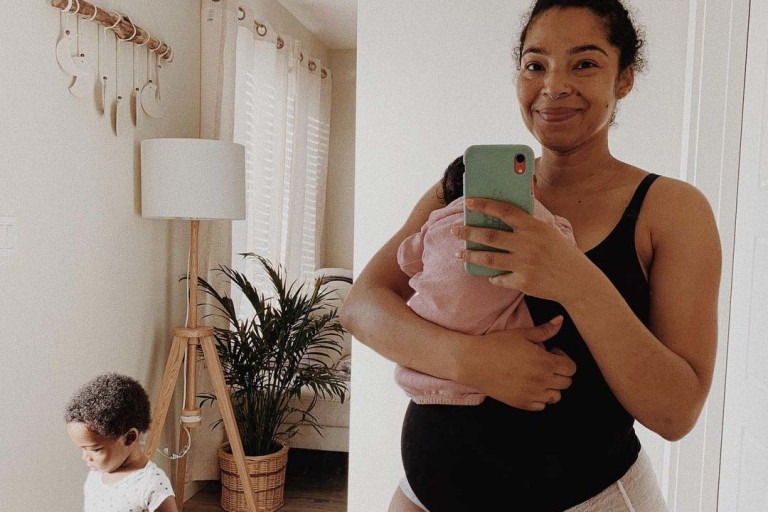
What Happens to Your Body After Birth
Erica Chidi of LOOM demystifies the changes your body goes through during those first weeks postpartum.

In This Article
I wish more pregnant people understood what happens to their bodies after birth. The first two weeks after birth are almost as transformative and foreign as all the changes you experienced during your pregnancy. Understanding what to expect and how to best prepare can help you during this time. Let's move through what you need to know.
Your belly after birth
After birth, don’t expect your belly to go back to normal instantly. In the first few days after birth, you’ll have a “pooch” or distension in your belly due to the fact that it takes about 6-10 weeks for your uterus to involute—which means to contract back down to its pre-pregnancy size.
Spending more time lying down and resting in this early stage can help your abdominal muscles to relax and gently usher the organs that moved out of the way to help your baby have space to move back into their natural place. Using a belly binder can also help assist with this—just make sure it’s not too tight.
Bleeding after birth
Whether you have a vaginal birth or a cesarean birth, you are going to continue to release blood out of your vagina. This blood—also known as lochia—is what's left of your uterine lining that used to help support the placenta and the pregnancy.
For the first 2-8 weeks postpartum, you bleed a small amount daily. The amount, consistency, and color of your blood will change over time, moving from dark red to pink and eventually disappearing altogether. Using reusable period underwear and disposable maxi pads can help make this process easier.
Breast engorgement after birth
Your breasts are going to change pretty considerably postpartum. They already have during your pregnancy, but after your baby is born and the placenta is released vaginally or surgically through a cesarean birth, your body begins to go into overdrive to make as much milk as your baby needs, which can make your breasts engorged.
Engorgement can be very painful, but there is a way to minimize any pain and discomfort by feeding your baby on demand. This means feeding your baby when they show you hunger cues or making sure your baby is feeding at the breast every three to four hours within the first two weeks of life or the first two weeks after birth.
If you're choosing to exclusively pump and feed your baby human milk, the same would apply. You would just make sure to pump and express milk from the breast every four hours for at least 20 minutes or more. Booby toobs, therashells and a good breast pump will be your best friends during this phase. It's also really important to have a lactation consultant help you in those first few days and weeks.
If you're not breastfeeding or pumping, your focus will be on reducing your milk supply and weaning—Earth Mama’s “No More Milk Tea," Ibuprofen, ice therapy, diffusing peppermint oil and crushed cabbage leaves can help reduce milk production and relieve discomfort during the weaning process.
Vaginal care after birth
Up to 9 in 10 first-time mothers who have a vaginal birth will experience some sort of tearing or grazing inside of their vagina. Tears happen as the baby stretches the vagina and the perineum during birth. They can occur around the labia, clitoris or inside the vagina.
First-degree tears typically heal quickly and without treatment. They are very unlikely to cause long-term problems, but they can be very sore. Second-degree tears typically affect the muscle of the perineum and the skin. These usually require stitches.
If you tear or feel discomfort after a vaginal delivery, make sure to use hot and cold therapy underwear pads for the first few days, plus a peri bottle to dilute your urine and stop your pee from irritating any tearing or stitches when you go to the bathroom. Soaking in a sitz bath can be soothing too.
Cesarean care after birth
Most of the early abdominal pain post-surgery should subside within 48 hours of the birth, but full recovery from a cesarean birth may take 4-6 weeks. Go lightly with physical activity, and know that you may need help lifting and feeding your baby for the first few days. Also, be mindful of any sudden movements like coughing or sneezing because they recruit your abdominal muscles, so if you feel a sneeze or cough coming on, put your hand over your belly near the incision site and bend forward slightly to minimize the strain on your muscles.
Pooping after birth
Pooping after a vaginal birth can feel really intense because it uses the same set of muscles that you use to push the baby out. So making pooping easier is an important part of supporting yourself. You can do this by eating soft, fibrous foods, drinking lots of water and maybe even adding in extra healthy fats, like avocados or coconut oil, to your meals.
Constipation is also common after a cesarean birth due to the medications used in the procedure, so make sure to take a stool softener. It also can be helpful to put your feet on a footstool when using the toilet, or order to raise your knees above your hips—this can help make pooping a little easier.